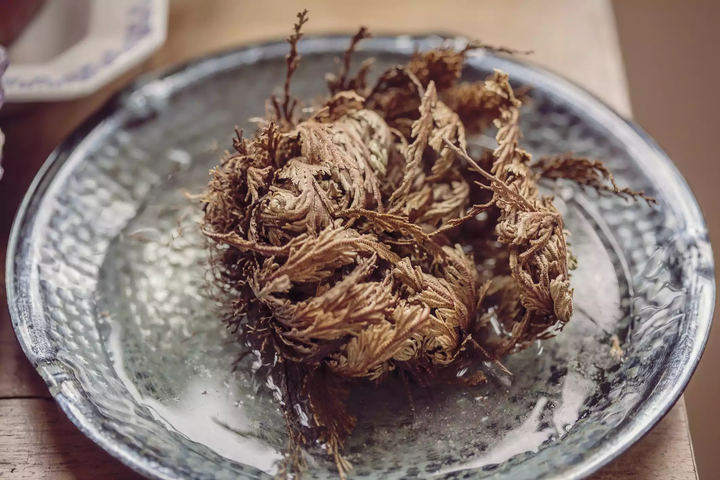Looking for an easy to grow plant that requires little water? Resurrection plants are for you! These plants can survive several years without water by drying up and going dormant, and "come back to life" within a couple of hours of being watered.
This amazing feat (which led to their common name) is actually a survival mechanism developed by resurrection plants (Selaginella lepidophylla) in the harsh conditions of their native habitat, the Chihuahuan Desert. In the desert when water is scarce, resurrection plants begin to dry out and curl their fronds inwards into a ball shape. Once dried, the dormant plants ‘travel’ around the desert as tumbleweeds until they find water. Once exposed to moisture again, resurrection plants "rehydrate" and unfurl their gorgeous, fern-like fronds.
Although resurrection plants are native to desert conditions, they adapt well to growing indoors. Read on to learn how to grow these unique, other-worldly plants and add this conversation starter to your home.
Botanical Name:
Selaginella lepidophylla
Common Name:
Resurrection plant, resurrection moss, rose of Jericho, false rose of Jericho, dinosaur plant, stone flower.
Plant Type:
Cold-tender perennial
Mature Size:
5cm tall
Sun Exposure:
Bright light
Soil Type:
None. Grows best in pebbles and water
Soil pH:
7.6-9.0
Bloom Time:
Doesn't flower (sporophyte)
Flower Color:
Doesn't flower (sporophyte)
Native Area:
Mexico, southwestern United States

How to Grow Resurrection Plants
Resurrection plants are easy, fail-proof plants to grow and if cared for properly, can be very long-lived. Some are even passed down through generations! They are a type of desert plant in the spikemoss family native to the Chihuahuan Desert, which spans parts of Mexico and the southwestern United States.
Their amazing drought-tolerance is one of the most unique features of resurrection plants. They can survive for up to seven years without water and lose up to 95% of their moisture content. This is accomplished by going into a state of dormancy that enables the plant to survive without cell or tissue damage.
As houseplants, resurrection plants are easy to care for. If you have purchased a resurrection plant in its dormant state, it will need to be rehydrated and taken out of dormancy. While resurrection plants do not require regular pruning, any dead ends that do not rehydrate can be trimmed off at this stage. Afterward, resurrection plants require little ongoing care and can be grown in water or in soil. It is also important to note that resurrection plants are sporophytes, which means that they do not produce seeds or flowers, but instead multiply through spores.
Light
Resurrection plants thrive in plenty of light. Choose a location that receives bright, indirect light. Avoid locations that receive scorching sun as this may be too much for a resurrection plant that has adapted to living indoors.
Soil
Soil is not a necessity for resurrection plants but can be used if desired. Resurrection plants will grow happily in water as long as they are given some rest periods. Alternatively, after resurrection plants are rehydrated in water they can be transferred to soil and grown as a healthy potted plant. Use a well-draining potting mix such as a mixture of one part sand, one part potting soil, and two parts humus.
Water
To rehydrate resurrection plants, place them in a container filled with pebbles and water. The water should reach just above the pebbles so that the plants can rest securely on top without submerging in the water too far. Resurrection plants are sensitive to water quality, so use distilled water, rainwater, or tap water that has been left out overnight when watering these plants.
Once placed in the water, it takes about 3-4 hours for a dried out resurrection plant to fully open again.
If grown in water, it is important to note that resurrection plants cannot survive in constant water and will begin to rot if left in water for too long. Dedicate one day a week as a water-free rest day, and every couple of weeks resurrection plants should be allowed to dry out completely.
Temperature and Humidity
Although resurrection plants are desert plants, they are sensitive to extreme temperature variations and should not be exposed to temperatures that are too hot or too cold. Generally, resurrection plants are happy in average room temperatures. However, avoid placing resurrection plants in locations next to drafty vents or windows.
Fertilizer
Resurrection plants require very little fertilizing. Feed twice a year with a water-soluble fertilizer, once in early spring and once mid-summer.
Toxicity
Not a lot is definitively known about resurrection plant toxicity as they are fairly new houseplants. However, resurrection plants are members of the spikemoss family, and as such, may be toxic to cats as many other species of spikemoss are.
Varieties
Selaginella lepidophylla is commonly confused with Anastatica hierochuntica, both of which are tumbleweeds and resurrection plants, and they share the common name “rose of Jericho” (although Anastatica is considered the ‘true’ rose of Jericho). However, these two types of resurrection plants are separate and distinct species that are native to two different continents. Anastatica hierochuntica is a member of the Brassicaceae family and is native to arid regions in the Middle East and the Sahara Desert while Selaginella lepidophylla is native to Mexico and parts of the United States and is a part of the spikemoss (Selaginellaceae) family.